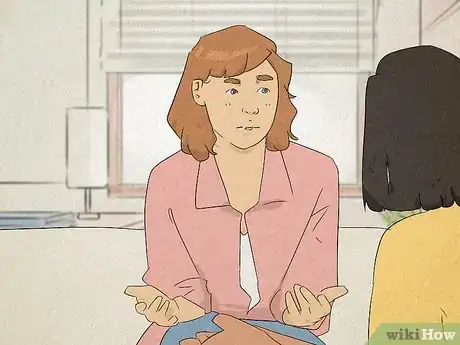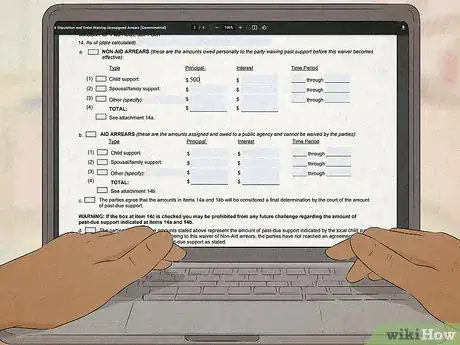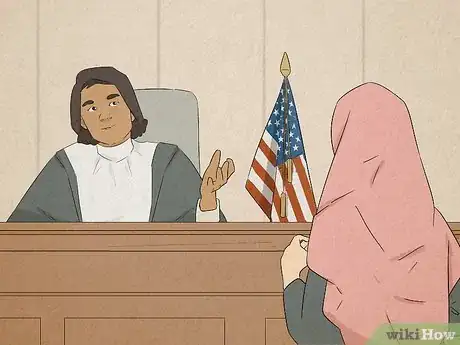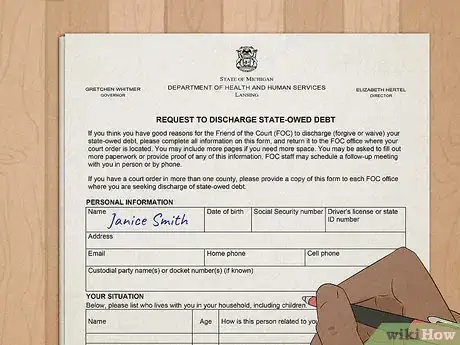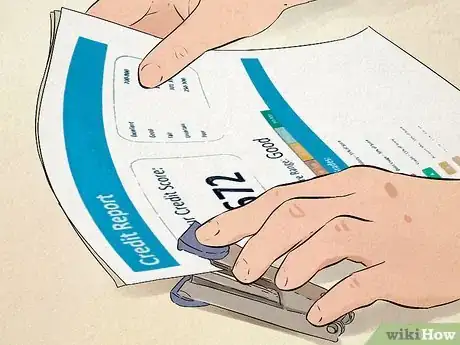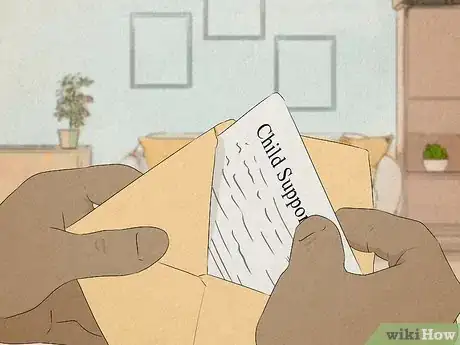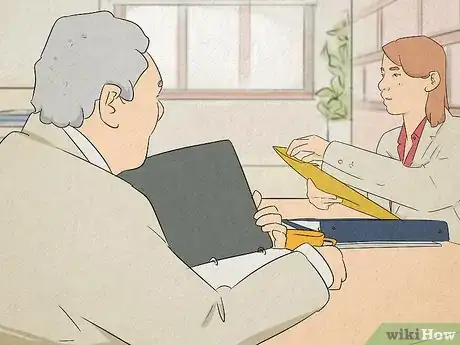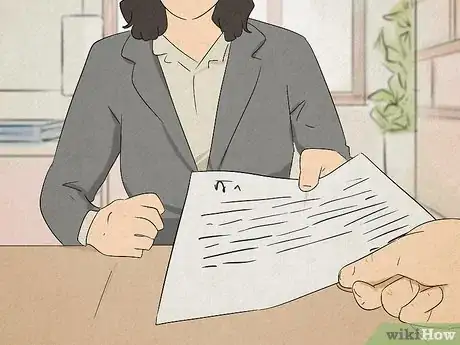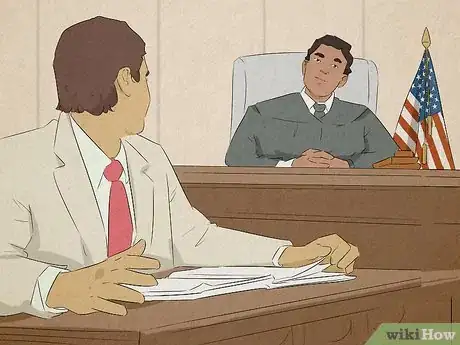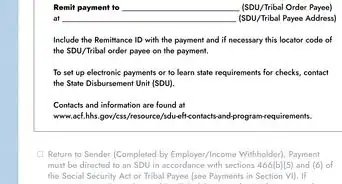This article was co-authored by Jennifer Mueller, JD. Jennifer Mueller is an in-house legal expert at wikiHow. Jennifer reviews, fact-checks, and evaluates wikiHow's legal content to ensure thoroughness and accuracy. She received her JD from Indiana University Maurer School of Law in 2006.
There are 12 references cited in this article, which can be found at the bottom of the page.
This article has been viewed 12,952 times.
As a parent, you can get behind on their child support payments through no fault of your own. For example, you might've lost your job or started working reduced hours, or you might've had extraordinary expenses that you don't normally budget for. If you feel like you're in over your head and want a fresh start, the good news is that you might be able to have at least part of those arrears forgiven. In the US, the process for doing this varies depending on what state you live in and whether you pay your child support directly to your co-parent or to the state.
Steps
Co-Parent Agreement
Do this if you're making child support payments directly to your co-parent.
-
1Schedule a meeting with your co-parent to discuss waiving your arrears. This is something you both need to sit down and talk about in a serious, objective way. Trying to bring it up over the phone or blindsiding them with the issue probably won't go over very well. Instead, reach out to your co-parent and tell them you want to talk about the child support you owe.[1]
- For example, you might call or text them and say, "Hey, I know that I owe you $2,000 in arrears. Things have been tough lately. I was wondering if we could sit down and have a conversation about that?"
- Get together financial documents and information ahead of the meeting. This helps your co-parent understand that you're being transparent about your financial situation and aren't just trying to avoid your obligations.
-
2Work through a mediator if you and your co-parent don't communicate well. Your local court clerk will have information about mediation programs you can use. The mediator will talk to you and your co-parent separately and help the two of you come to an agreement.[2]
- While you do typically have to pay a mediator, many offer their services on a sliding-fee scale, which makes it more affordable. Some mediators also work on a volunteer basis.
- Judges typically want to make sure that your co-parent agreed to waive arrears voluntarily.[3] If you have a history of intimidating your co-parent, working through a mediator is added security, even if your relationship is in a different place now.
- In some states, the judge won't approve any modification, including a waiver of arrears, unless both parents agree to it.[4]
Advertisement -
3Negotiate with your co-parent to waive your arrears. Brainstorm several different solutions to the problem that you can present to your co-parent. If the most attractive option for you is that your co-parent simply waives (or forgives) the arrears and says you no longer have to pay them, lead with that. But have a few compromises in mind as well.[5]
- If your co-parent has legitimately been getting along just fine without the money you owe and the children are well taken care of, they might not mind simply forgiving the arrears. It's pretty uncommon for that to happen, but it's not unheard of and it's always worth a shot to ask.
- For example, you might offer to pay the co-parent a lump sum immediately in exchange for waiving the rest of the arrears you owe. Even if the lump sum is a lot less than the total you owe, a lot of people are more willing to compromise if they get a good sum of money upfront.
- If you can't handle a large lump sum, you might also offer to make a payment on top of the regular child support until a portion of the arrears is paid, in exchange for waiving the rest of them. For example, you might make a $100 payment each month until you've paid $1,000, and your co-parent agrees to waive the other $1,000.
-
4Write up your agreement or have a lawyer do it for you. Many courts, such as those in California, have fill-in-the-blank forms you can use to put your agreement in writing.[6] Look on the court's website or visit the clerk of court's office to get a form. If there's not a form, or if you'd just feel better if a lawyer did it, that's an option as well.
- Typically, you'll also need a document called a "Motion," which you use to ask the court to change a pre-existing order. The court clerk's office has fill-in-the-blank forms you can use for this.[7]
- Most people go back to the lawyer they used for the original order for this. If that lawyer is no longer available, any other lawyer who specializes in family law can write up an agreement to waive child support arrears.
-
5Submit your agreement to the court that issued the original order. The court that issued the original order retains jurisdiction over it, which means only that court can change it. Take your paperwork to the clerk's office and tell the clerk you want to file it.[8]
- The clerk will typically set a hearing for your motion, although some judges don't have live hearings for these types of motions as long as both parents agree.
-
6Attend the hearing on your motion if required. If both you and your co-parent agree on the modification, only one of you has to attend the hearing—but it's usually better if you both go so the judge can see that you agree. The judge will review your agreement and make a decision based on the best interests of your child.[9]
- Keep in mind that even if you and your co-parent agree, the judge might not. It's their job to look at all the surrounding circumstances and make the decision they think is best for your child.
- It's not common for a judge to refuse a change both parents agree on, but it does happen. If the judge doesn't like the change you've proposed, they might suggest some other options you can use instead.
State Waiver or Discharge
This method is appropriate if a state child support agency has taken over your case and is collecting child support payments from you and distributing them on your behalf.
-
1Contact the child support agency in charge of your case. To find contact information for your local child support agency, go to https://www.acf.hhs.gov/css/map/state-and-tribal-child-support-agency-contacts and click on the state where the child lives or where the original child support order was entered. Then, call the number provided and say you want to discuss your child support arrears.[10]
- Be upfront about any change in your financial circumstances. For example, if you've lost your job, let the caseworker know when you lost your job and what you've been doing to find a new one.
-
2Ask about debt compromise, forgiveness, or arrears management. Different states call these programs by different names, but they all accomplish the same basic goal. Through these programs, some or all of your arrears are waived. In exchange, you make specific payments as agreed. Often, these payments are automatically deducted from your paychecks.[11]
- Usually these programs don't forgive all of your arrears, only a portion of them. Under the agreement, you'd still need to make your regular child support payments plus a debt payment to cover the portion of your arrears that wasn't forgiven.
- Don't make any promises to the caseworker that you don't think you can keep. Most debt compromise plans have conditions attached—if you don't think you can meet those conditions, say so. There might be something else they can do.
-
3Fill out a form requesting a discharge of your arrears. The child support agency will have a form for you to fill out if you meet the requirements for their debt reduction program. The caseworker might mail a paper form to you, but usually, they'll email it to you. You might also be able to download the form directly from their website. On the form, you'll enter information about yourself, your child or children, your child support obligation, your arrears, and your financial situation.[12]
- The child support agency is looking for changes in your financial situation since child support was originally calculated for you. Those changes could also result in a reduction in your child support payments in the future.
-
4Copy and attach documentation of your current financial situation. Typically, you'll need documents that prove the details about your financial situation that you described on your request form. The specific documents you'll need depend on your situation, but might include any of the following:[13]
- Current pay stubs
- Recent bank account information (savings or checking account statements)
- Public benefit award letters
- Recent credit report
- Proof of a bankruptcy filing
- Current and recent bills
- Court or incarceration documents
- Recent income tax returns
-
5Wait for a decision from the child support agency. After the child support agency gets your request and documentation, a caseworker will review the file and decide whether full or partial forgiveness of your arrears is appropriate. The specific timeline differs depending on the state agency and the volume of requests they receive, so be patient.[14]
- Make sure you're continuing to make child support payments to the extent that you're able to while the agency is reviewing your case. Your request is more likely to be approved if you show that you're making a good-faith effort.
Reduction of Future Payments
If you've had a change in financial circumstances, getting your payments reduced can decrease your future obligation. While it typically won't do anything about your arrears, it will keep them from continuing to pile up.[15]
-
1Get a copy of the original child support order. If you don't have a copy of this with your important papers you can request one from the child support agency in charge of your case or the court that issued the order. On the document, look at the figures that show how your child support obligation was calculated and the amount of income you reported at that time.[16]
- If your income has substantially decreased since the award was entered, or your expenses have substantially increased, it's more likely that a judge would reduce your child support payments as a result.
- Judges will also look at temporary circumstances that cause a substantial change in your financial circumstances. For example, if you were recently severely ill and have outstanding medical bills, those circumstances might warrant a reduction in your child support, at least on a temporary basis.
-
2Gather documentation of any recent financial changes. Use documentation that also shows the date when the change occurred. This allows the court to properly determine the date when the reduction in child support should have started. If the change happened several months ago, your arrears would be reduced or dismissed as well, depending on when you started accruing arrears.[17]
- For example, suppose you lost your job 6 months ago and also stopped making child support payments. The court would determine how much child support you should have been paying based on your income after you lost your job, then reduce your arrears appropriately.
-
3Ask the child support agency to review the support order. In some states, such as Florida, the child support agency can review and change the child support order if you ask.[18] If your child support agency isn't able to do this, they can still help explain the court procedure and help you with any forms you'll need.
- If you need your child support reduced because of a change in your financial circumstances, you'll typically have to provide the child support agency with documentation of that change.
- Administrative review is usually going to be quicker and less expensive than getting the order changed through the court, so if this option is available to you, take advantage of it.
-
4Talk to your co-parent about modifying the child support order. In some states, such as Michigan, the court won't modify a child support order unless both parents agree.[19] Even if courts in your state would review a request to reduce child support without the other parent's cooperation, it's better if you're both on board.
- Let your co-parent know why you want to modify the child support. Make sure they understand that you want to do this because of a change in your financial circumstances, and be ready to provide documentation of that change if they ask for it.
-
5File a motion with the court to modify your child support. Call the clerk's office of the court that entered the original order and ask for a form. You might be able to download it from their website—if not, you can go to the clerk's office and pick up a paper copy to fill out. When you're done, turn it in to the court clerk.[20]
- In your motion, indicate that you have arrears. Attach documentation of the total amount of your arrears and when you started accruing them.
- There will usually be a fee to file the motion and have it served on your co-parent. If you can't afford the fee, tell the clerk you want to apply for a waiver. You usually automatically qualify for a waiver if you're receiving public benefits.[21]
-
6Seek a reduction if one of your children is over 18. Once your child reaches the age of majority (extended to 19 or 21 in some states), you're no longer responsible for child support. The child support order typically doesn't terminate automatically, though—you have to go to court to stop it. If you don't go to court, you'll be expected to continue to pay child support and can rack up arrears.[22]
- Often, you'll continue to pay the same amount of child support for your remaining kids unless you specifically ask to have it reduced. For example, if you're paying $800 a month for 2 kids and one of them turns 18, you'd still be paying $800 a month for the remaining child unless you asked for a reduction.
- In some states, such as Kansas, child support is automatically modified or terminated after your child's 18th birthday. But if your financial circumstances have changed, you might still need to ask the court to lower your child support further.[23]
Warnings
- This article discusses how to get child support arrears dismissed in the United States. If you live in another country, talk to an attorney who specializes in family law and child support.⧼thumbs_response⧽
- Family law differs significantly from state to state. This article provides a general overview but the specifics might be different where you live.⧼thumbs_response⧽
- While you're trying to get your arrears dismissed, it's important that you continue to make your regular child support payments to the extent that you're able to do so. Failure to make child support payments as agreed can nullify any agreement to waive arrears.[25]⧼thumbs_response⧽
References
- ↑ https://michiganlegalhelp.org/self-help-tools/family/i-need-help-managing-my-child-support-debt#
- ↑ https://www.vermontjudiciary.org/family/family-mediation-program
- ↑ https://michiganlegalhelp.org/self-help-tools/family/i-need-help-managing-my-child-support-debt#
- ↑ https://michiganlegalhelp.org/self-help-tools/family/i-need-help-managing-my-child-support-debt#
- ↑ https://michiganlegalhelp.org/self-help-tools/family/i-need-help-managing-my-child-support-debt#
- ↑ https://www.courts.ca.gov/documents/fl626.pdf
- ↑ https://www.kansaslegalservices.org/node/1576/faqs-about-child-support
- ↑ https://www.peoples-law.org/legal-overview-child-support
- ↑ https://www.courts.ca.gov/documents/fl626.pdf
- ↑ https://www.acf.hhs.gov/sites/default/files/documents/ocse/changing_a_child_support_order.pdf
- ↑ https://www.acf.hhs.gov/sites/default/files/documents/ocse/changing_a_child_support_order.pdf
- ↑ https://michiganlegalhelp.org/sites/default/files/assets/dhs-681_3-21_fillable_pdf.pdf
- ↑ https://www.3rdcc.org/Documents/FamilyDomestic/FOC/Miscellaneous/FD-FOC%204127%20Discharge%20of%20State%20Owed%20Arrears%5E%5E%5E.pdf
- ↑ https://www.3rdcc.org/Documents/FamilyDomestic/FOC/Miscellaneous/FD-FOC%204127%20Discharge%20of%20State%20Owed%20Arrears%5E%5E%5E.pdf
- ↑ https://www.kansaslegalservices.org/node/1576/faqs-about-child-support
- ↑ https://www.acf.hhs.gov/sites/default/files/documents/ocse/changing_a_child_support_order.pdf
- ↑ https://www.kansaslegalservices.org/node/1576/faqs-about-child-support
- ↑ https://floridarevenue.com/childsupport/change_support_orders/Pages/change_support_orders.aspx
- ↑ https://michiganlegalhelp.org/self-help-tools/family/i-need-help-managing-my-child-support-debt#
- ↑ https://www.kansaslegalservices.org/node/1576/faqs-about-child-support
- ↑ https://www.courts.ca.gov/selfhelp-feewaiver.htm?rdeLocaleAttr=en
- ↑ https://www.in.gov/dcs/child-support/non-custodial-parent-information/child-support-orders/
- ↑ https://www.kansaslegalservices.org/node/1576/faqs-about-child-support
- ↑ https://cssd.dc.gov/page/changes-custody
- ↑ https://www.courts.ca.gov/documents/fl626.pdf


